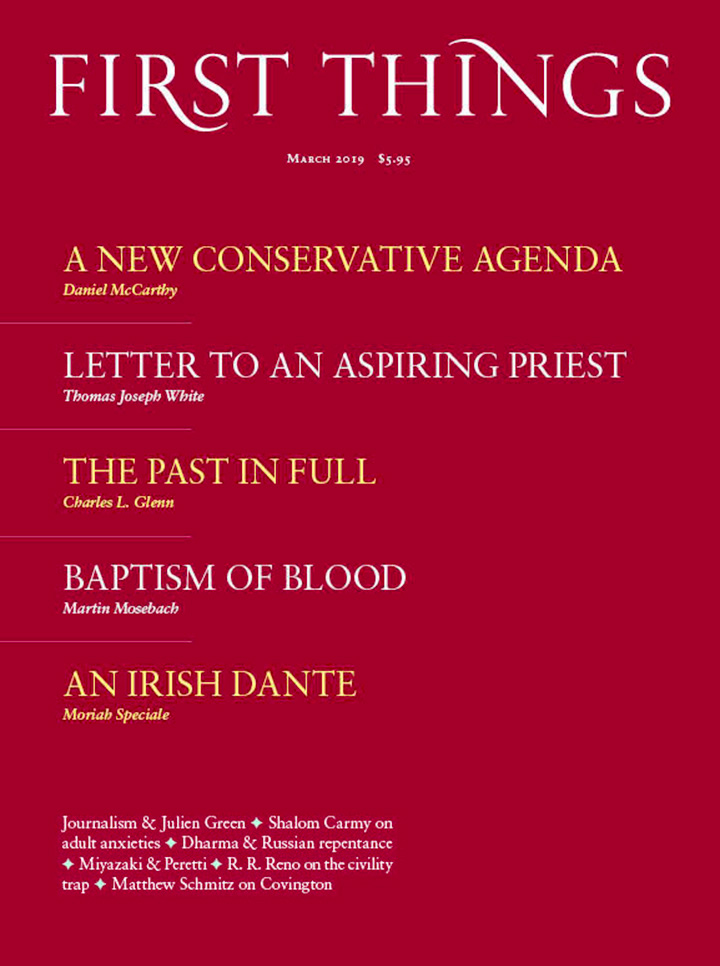On the basis of a sixty-second clip, thousands of prominent Americans rushed to denounce the students of Covington Catholic High School. The students’ alleged crime was mobbing an American Indian activist named Nathan Phillips while wearing “Make America Great Again” caps. Respectable people judged that the students should be expelled from high school, barred from college, shamed for life, even killed.
When fuller video footage established that Phillips had accosted the young men, who in turn had behaved with relative restraint, observers asked how so many well-meaning people could get it so wrong—not merely rushing to judgment, but reveling in the frenzy, as though striving to be more outrageously outraged than everyone else; displaying, in the name of kindness, an unreasoning cruelty. Some blamed liberal media bias, despite the fact that conservatives had been among the most vociferous in denunciation. Others blamed social media, which certainly encourages rash judgment and pile-ons. House Democrats began to investigate the possibility that foreign agents had been involved. Such explanations allow us to avoid reckoning with the fact that America long has been and still remains a nation of sentimental moralists. Unless this changes, our leading citizens will continue to indulge in spasms of performative outrage.
Oscar Wilde defined the sentimentalist as one “who desires to have the luxury of an emotion without paying for it.” A sentimental moralist is one who desires the luxury of a moral response—the undeniable pleasure of righteous indignation, the delectable horror at the evil of others—without paying the cost. He need not uphold a consistent morality in order to indulge in moral denunciation. He need not bother with ascertaining facts, because justice in any particular case is not the point. His censures exist to assure himself and others that he is a good and well-meaning person. Because he confuses feelings with morality, he invariably condemns others for their lack of feeling.
In the Covington affair, Catholic bishops, woke witches, celebrity priests, new atheists, and vague agnostics all joined in a frenzy of emoting over the supposed crimes of the unfeeling. Mark Harris of Vulture was repulsed by Nicholas Sandmann’s “smug, fixed, chilly smile.” Ruth Graham of Slate called it “the face of self-satisfaction and certitude, of edginess expressed as cruelty.” Bishop John Stowe of the neighboring diocese of Lexington announced that he was “ashamed” of the students for embracing a “politics of hate.” Alyssa Milano tweeted that “without white boys being able to empathize with other people, humanity will continue to destroy itself.” John Fugelsang declared Sandmann and his classmates “a model for modern US Christian Fundamentalism,” on account of their decision to “reject empathy.”
In condemning the students’ coldness, these people expressed extremes of emotion. Congresswoman Deb Haaland called the video “heartbreaking.” The actor Ron Perlman found it “soul crushing.” Ruth Graham called it “one of the most viscerally enraging images of an era that has offered no shortage of them.” Erik Abriss of Vulture wrote, “I’ve truly lost the ability to articulate the hysterical rage, nausea, and heartache this makes me feel. I just want these people to die. Simple as that. Every single one of them. And their parents. … F***ing die.”
The sentimental moralist deals in caricature, casting the victim as wholly innocent and the persecutor as unfathomably evil. No matter how complex the incident, he sees it as a standoff between Christ and his persecutors, Uncle Tom and Simon Legree. Nicholas Frankovich of National Review wrote that the students had taken on a “momentary role as Roman soldiers to [Nathan Phillips’s] Christ.” Christopher Mathias of Huffpost tweeted an image of Sandmann alongside one of segregationists taunting civil rights activists. Fr. James Martin, S.J., praised “the quiet dignity” of Phillips and advised that the students “could learn much from this elder.” The Atlantic’s Adam Serwer said, “This era is just a series of extremely heavy-handed metaphors”—an unwitting admission that the liberal imagination trades in clichés.
What matters to the sentimental moralist is that he feel right, even if he happens to be wrong. After the initial clip had been shown to be misleading, Milano announced, “I won’t apologize to these boys . . . But I will thank them. I will thank them for lighting a fire underneath the conversation about systemic racism and misogyny in this country.” Graham opined that it would be “misguided to let the complexities of the scene . . . dissuade us from telling the truth about who Trump is and exactly what he stands for.” Her assessment of the scene may not have been accurate, but somehow it was still right.
At the end of Uncle Tom’s Cabin, Harriet Beecher Stowe addresses readers who have been moved by the martyrdom of Uncle Tom at the hands of Simon Legree. What can they do to combat the injustice of slavery?
There is one thing that every individual can do, they can see to it that they feel right. An atmosphere of sympathetic influence encircles every human being; and the man or woman who feels strongly, healthily and justly, on the great interests of humanity, is a constant benefactor to the human race. See, then, to your sympathies in this matter!
America has changed very little since Stowe’s day. The individuals who declared their extreme distress after viewing the encounter between Sandmann and Phillips were indicating to themselves and others that they felt “strongly, healthily, and justly,” and were thereby advancing the “great interests of humanity.” They not only felt right; they felt righteous. Their passion justified their cruelty.
Stowe drew on a longstanding Protestant tradition of taking feelings as a divine guide. Thomas Paine had already put that tradition to political uses in “Common Sense.” He asked his readers to judge British actions by those “feelings and affections which nature justifies, and without which, we should be incapable of discharging the social duties of life.” The political community’s very existence depended on its citizens’ ability to experience properly strong emotion. “The social compact would dissolve, and justice be extirpated from the earth,” Paine writes, “were we callous to the touches of affection.”
As America’s influence has grown, so has the power of liberal sentiments. What Baudrillard called “the New Sentimental Order” now overspreads the world. Government officials, non-profit directors, CEOs, and churchmen have all become “consumers of the ever delightful spectacle of poverty and catastrophe, and of the moving spectacle of our own efforts to alleviate it.” This is not casual entertainment. Like the Christians who need to go through regular emotional revival experiences to be sure that they are numbered among the elect, we require the spectacle of outrageous injustice to be sure that we retain liberal sympathies.
It is no accident that these frenzies of sentimental moralism are often directed against more traditional forms of religion, especially the Catholic Church. A society that opposes reason to emotion, hierarchy to freedom, and dogma to truth will always view Catholicism as the enemy of the sentimental-liberal community. One can see this in The Awful Disclosures of Maria Monk (1835). This tract, written by a woman who claimed to have escaped a convent but in fact had been recently released from an asylum, purports to detail the crimes that take place in Catholic convents. Its lurid—and ludicrous—scenes elicited the sincere outrage of respectable Americans in the nineteenth century.
Monk tells her readers how religious regimens make Catholics lose their natural sympathy. “We could not . . . mortify our feelings too far. This was to be done by opposing them, and acting contrary to them.” In a climactic scene, Monk has to repress her feelings as she watches a priest and various “cold-blooded” nuns crush another nun by jumping up and down on a bed under which she is pinned. Those Catholics, so unfeeling! As Wilde said of the death of Dickens’s Little Nell, one would need a heart of stone not to laugh.
Of course, no one was laughing when anti-Catholic mobs in the era of Maria Monk burned down the Ursuline Convent in Boston. No one was laughing when death threats were issued against the allegedly unfeeling students of Covington Catholic, an unidentified package arrived at their bishop’s chancery, and a mob tried to disrupt Mass at the National Shrine. In these sentimental frenzies, empathy masks cruelty, and wrong is done so that we might feel right.
Matthew Schmitz is senior editor of First Things.
Photo by Jon Stegenga/Humanizing Through Story.
Begging Your Pardon
Who attempts to overthrow a government without weapons? Why would the alleged leader of an insurrection authorize…
Pharmacists Should Not Be Allowed to Prescribe Abortion Pills
At the end of 2024, Washington State implemented a month-long pilot program that allowed some pharmacists to prescribe mifepristone…
The End of Trudeau’s Pseudo-Caesarism
When Barack Obama first won the presidency in 2008, he ushered in a distinctive left-liberal aesthetic of…



